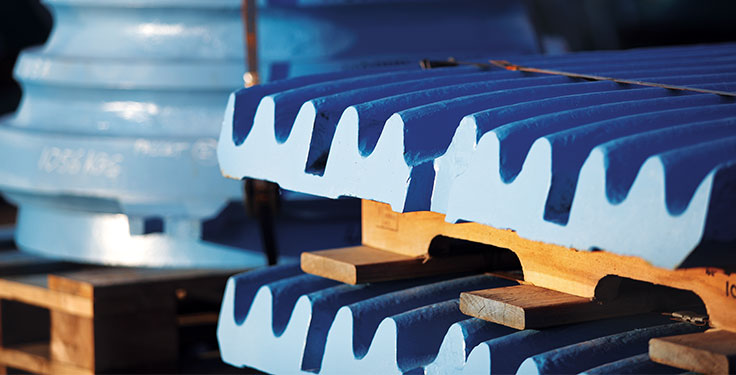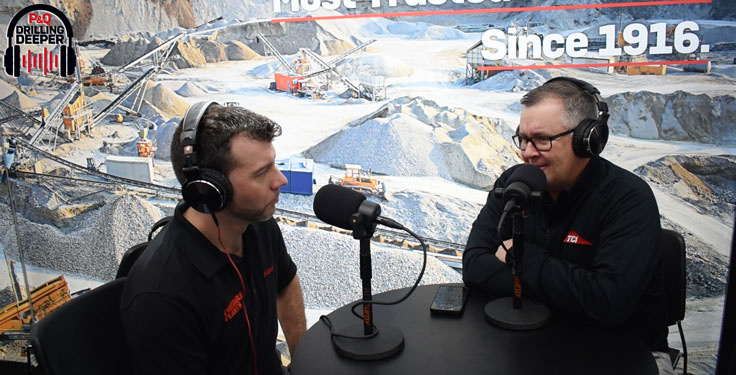Tips to select the right manganese for your crushing operation

When selecting manganese wear parts, producers must consider the material they’re crushing as well as the type of crusher they’re using. Photo: Mellott Company
In the late 1800s, Sir Robert Hadfield sought a way to make steel alloys less brittle.
Hadfield, a British metallurgist, was finally able to develop a material that did not break from heavy impact after years of trial and error and countless tests. The metal he used to accomplish this feat was manganese.
Manganese, which is atomic No. 25 on the periodic table, is one of the most common transition elements in the earth’s crust. While it is hard, it is also very brittle. And it wasn’t until Hadfield combined manganese with steel that its industrial uses became apparent.
Fast forward to today, and manganese is used in steel alloys across the aggregate industry. It’s particularly useful in wear part applications.
Manganese is not a one-size-fits-all solution, though. Alloys with different levels of manganese content have different characteristics.
As you explore manganese parts for your rock crushing operation, here are some considerations to make for choosing the right ones.
Wear parts and manganese
Let’s start with the basics: Why should you choose manganese wear parts for your crushing operation at all?
The basic answer – one Hadfield uncovered long ago – is that manganese alloys are work-hardening metals, meaning the harder you hit them, the harder they get. In wear part applications, material is hit over and over, so manganese steel is ideally suited for durability in this role.
Manganese has been used accordingly for more than a century. But while higher manganese content in an alloy makes it harder, it also makes it more brittle. The upshot of this is that pure manganese doesn’t make for good wear parts. Instead, different ratios of manganese are used, along with steel and other materials, for different applications.
Factors impacting wear parts

Manganese is used in steel alloys across the aggregate industry. Photo: Mellott Company
When choosing manganese wear parts, there are three key considerations to make.
1. The material being crushed. Is the rock hard (i.e., granite) or soft (i.e., limestone, sandstone)? What size is it being crushed to? How has material been prepped? If material is being recycled, is tramp metal included?
2. The final product. What is the final size of the product?
3. The crusher used. Is it a jaw or a cone crusher? What’s the make and model? And what are the manufacturer’s specifications for wear parts?
With these questions in mind, there are a few common manganese content levels whose wear parts are fits for certain applications, including:
■ 11 to 14 percent manganese wear parts. This represents the lower end of the spectrum. Wear parts that are 11 to 14 percent manganese are more ductile and more durable, and they’ll also work-harden the fastest. This means they’re best suited for very low-abrasion, lower-strength rock.
■ 18 percent manganese wear parts. This represents the middle of the spectrum. Eighteen percent manganese wear parts are middle-of-the-road when it comes to abrasion resistance and the rate at which parts work-harden. As a result, 18 percent manganese is one of the most commonly used ratios. Outside of limestone, it works for the majority of applications.
■ 22 to 24 percent manganese wear parts. Finally, 22 to 24 percent manganese wear parts represent the high end of the spectrum. At this level of manganese, wear parts are brittle, and so they’re only suited for high-abrasion material that’s even more brittle.
Final thoughts
As illustrated, there’s a lot that goes into selecting the right manganese wear parts for your crushing application. The good news for many crushing operations is that if you’re ordering wear parts, you’re likely replacing worn-out ones. So you should know the specifications of your replacement parts.
If this is the case – or if you simply know the parts you need – getting the right part is simple. If you aren’t sure which manganese wear parts are needed, the right equipment supplier can surely help you identify the parts that will best serve your needs.
Information for this article courtesy of Pat Mearkle, vice president of parts operations and supply chain at Mellott Company.









